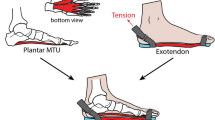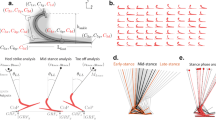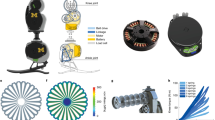Abstract
Falls and subsequent complications are major contributors to morbidity and mortality, especially in older adults. Here, by taking inspiration from claws and scales found in nature, we show that buckling kirigami structures applied to footwear outsoles generate higher friction forces in the forefoot and transversally to the direction of movement. We identified optimal kirigami designs capable of modulating friction for a range of surfaces, including ice, by evaluating the performance of the dynamic kirigami outsoles through numerical simulations and in vitro friction testing, as well as via human-gait force-plate measurements. We anticipate that lightweight kirigami metasurfaces applied to footwear outsoles could help mitigate the risk of slips and falls in a range of environments.
This is a preview of subscription content, access via your institution
Access options
Access Nature and 54 other Nature Portfolio journals
Get Nature+, our best-value online-access subscription
$29.99 / 30 days
cancel any time
Subscribe to this journal
Receive 12 digital issues and online access to articles
$99.00 per year
only $8.25 per issue
Buy this article
- Purchase on Springer Link
- Instant access to full article PDF
Prices may be subject to local taxes which are calculated during checkout




Similar content being viewed by others
Data availability
The main data supporting the results of this study are available within the paper and its Supplementary Information. All of the data generated in this study, including the source data and the data used to make the figures, are available from figshare with the identifier https://doi.org/10.6084/m9.figshare.12207992.
Code availability
The ABAQUS scripts used for the numerical analyses are available as Supplementary Information.
References
Injury Facts. National Safety Council https://injuryfacts.nsc.org/ (2017).
Li, K., Courtney, T. & Huang, Y. Slipping and falling experience and perception of floor slipperiness: a field survey in 10 fast-food restaurants in Taiwan. Prof. Saf. 51, 34–38 (2006).
Morrison, R., Chassin, M. & Siu, A. The medical consultant’s role in caring for patients with hip fracture. Ann. Intern. Med. 128, 1010–1020 (1998).
Wolinsky, F. D., Fitzgerald, J. F. & Stump, T. E. The effect of HIP fracture on mortality, hospitalization, and functional status: a prospective study. Am. J. Public Health 87, 398–403 (1997).
Panula, J. et al. Mortality and cause of death in hip fracture patients aged 65 or older—a population-based study. BMC Musculoskelet. Disord. 12, 105 (2011).
LeBlanc, E. S. et al. Hip fracture and increased short-term but not long-term mortality in healthy older women. Arch. Intern. Med. 171, 1831–1837 (2011).
Tinetti, M. E. et al. A multifactorial intervention to reduce the risk of falling among elderly people living in the community. N. Engl. J. Med. 331, 821–827 (1994).
Englander, F., Hodson, T. & Terregrossa, R. Economic dimensions of slip and fall injuries. J. Forensic Sci. 41, 733–746 (1996).
Hsu, J. et al. Slip resistance of winter footwear on snow and ice measured using maximum achievable incline. Ergonomics 59, 717–728 (2016).
Stevens, J. A., Corso, P. S., Finkelstein, E. A. & Miller, T. R. The costs of fatal and non-fatal falls among older adults. Inj. Prev. 12, 290–295 (2006).
Bureau of Labor Statistics, US Department of Labor. 42,480 work injuries involved ice, sleet, or snow in 2014. The Economics Daily https://www.bls.gov/opub/ted/2016/42480-work-injuries-involved-ice-sleet-or-snow-in-2014.htm (2016).
Chang, W. R., Leclercq, S., Lockhart, T. E. & Haslam, R. State of science: occupational slips, trips and falls on the same level. Ergonomics 59, 861–883 (2016).
Hanson, J. P., Redfern, M. S. & Mazumdar, M. Predicting slips and falls considering required and available friction. Ergonomics 42, 1619–1633 (1999).
Gao, C. & Abeysekera, J. A systems perspective of slip and fall accidents on icy and snowy surfaces. Ergonomics 47, 573–598 (2004).
Gao, C., Holmér, I. & Abeysekera, J. Slips and falls in a cold climate: underfoot surface, footwear design and worker preferences for preventive measures. Appl. Ergon. 39, 385–391 (2008).
Bruce, M., Jones, C. & Manning, D. P. Slip-resistance on icy surfaces of shoes, crampons and chains—a new machine. J. Occup. Accid. 7, 273–283 (1986).
Gard, G. & Berggård, G. Assessment of anti-slip devices from healthy individuals in different ages walking on slippery surfaces. Appl. Ergon. 37, 177–186 (2006).
Berggård, G. & Johansson, C. Pedestrians in wintertime—effects of using anti-slip devices. Accid. Anal. Prev. 42, 1199–1204 (2010).
Gao, C., Abeysekera, J., Hirvonen, M. & Grönqvist, R. Slip resistant properties of footwear on ice. Ergonomics 47, 710–716 (2004).
Menant, J. C., Steele, J. R., Menz, H. B., Munro, B. J. & Lord, S. R. Optimizing footwear for older people at risk of falls. J. Rehabil. Res. Dev. 45, 1167–1181 (2008).
Blees, M. K. et al. Graphene kirigami. Nature 524, 204–207 (2015).
Rafsanjani, A. & Bertoldi, K. Buckling-induced kirigami. Phys. Rev. Lett. 118, 084301 (2017).
Tang, Y. et al. Programmable kiri-kirigami metamaterials. Adv. Mater. 29, 1604262 (2017).
Zhang, Y. et al. A mechanically driven form of kirigami as a route to 3D mesostructures in micro/nanomembranes. Proc. Natl Acad. Sci. USA 112, 11757–11764 (2015).
Liu, Z. et al. Nano-kirigami with giant optical chirality. Sci. Adv. 4, eaat4436 (2018).
Wu, C., Wang, X., Lin, L., Guo, H. & Wang, Z. L. Paper-based triboelectric nanogenerators made of stretchable interlocking kirigami patterns. ACS Nano 10, 4652–4659 (2016).
Jang, N. S. et al. Simple approach to high-performance stretchable heaters based on kirigami patterning of conductive paper for wearable thermotherapy applications. ACS Appl. Mater. Interfaces 9, 19612–19621 (2017).
Rafsanjani, A., Zhang, Y., Liu, B., Rubinstein, S. M. & Bertoldi, K. Kirigami skins make a simple soft actuator crawl. Sci. Robot. 3, eaar7555 (2018).
Dias, M. A. et al. Kirigami actuators. Soft Matter 13, 9087–9092 (2017).
Zheng, W. et al. Kirigami-inspired highly stretchable nanoscale devices using multidimensional deformation of monolayer MoS 2. Chem. Mater. 30, 6063–6070 (2018).
Morikawa, Y. et al. Ultrastretchable kirigami bioprobes. Adv. Healthc. Mater. 7, 1701100 (2018).
Shyu, T. C. et al. A kirigami approach to engineering elasticity in nanocomposites through patterned defects. Nat. Mater. 14, 785–789 (2015).
Ma, R., Wu, C., Wang, Z. L. & Tsukruk, V. V. Pop-up conducting large-area biographene kirigami. ACS Nano 12, 9714–9720 (2018).
Song, Z. et al. Kirigami-based stretchable lithium-ion batteries. Sci. Rep. 5, 10988 (2015).
Wilson, A. M. et al. Locomotion dynamics of hunting in wild cheetahs. Nature 498, 185–189 (2013).
Skutch, A. F. Helpers At Birds’ Nests: Cooperative Breeding and Related Behaviour (Univ. of Iowa Press, 1999).
Marvi, H. & Hu, D. L. Friction enhancement in concertina locomotion of snakes. J. R. Soc. Interface 9, 3067–3080 (2012).
Guo, Z. V. & Mahadevan, L. Limbless undulatory propulsion on land. Proc. Natl Acad. Sci. USA 105, 3179–3184 (2008).
Suh, N. P. & Sin, H.-C. The genesis of friction. Wear 69, 91–114 (1981).
Lee, D. W., Banquy, X. & Israelachvili, J. N. Stick-slip friction and wear of articular joints. Proc. Natl Acad. Sci. USA 110, 567–574 (2013).
Das, S. et al. Stick–slip friction of gecko-mimetic flaps on smooth and rough surfaces. J. R. Soc. Interface 12, 20141346 (2015).
Giakas, G. & Baltzopoulos, V. Time and frequency domain analysis of ground reaction forces during walking: an investigation of variability and symmetry. Gait Posture 5, 189–197 (1997).
Lieberman, D. E. et al. Foot strike patterns and collision forces in habitually barefoot versus shod runners. Nature 463, 531–535 (2010).
Li, K. W. et al. The effect of shoe sole tread groove depth on the friction coefficient with different tread groove widths, floors and contaminants. Appl. Ergon. 37, 743–748 (2006).
Yamaguchi, T. & Hokkirigawa, K. Development of a high slip-resistant footwear outsole using a hybrid rubber surface pattern. Ind. Health 52, 414–423 (2014).
Yamaguchi, T. et al. Efficacy of a rubber outsole with a hybrid surface pattern for preventing slips on icy surfaces. Appl. Ergon. 51, 9–17 (2015).
Rizvi, R., Naguib, H., Fernie, G. & Dutta, T. High friction on ice provided by elastomeric fiber composites with textured surfaces. Appl. Phys. Lett. 106, 111601 (2015).
Ion, A., Kovacs, R., Schneider, O., Lopez, P., & Baudisch, P. Metamaterial textures. In Proc. CHI Conference on Human Factors in Computing Systems 336 (Association for Computing Machinery, 2018).
Iraqi, A., Cham, R., Redfern, M. S., Vidic, N. S. & Beschorner, K. E. Kinematics and kinetics of the shoe during human slips. J. Biomech. 74, 57–63 (2018).
McGorry, R. W., Chang, C. C. & DiDomenico, A. Rearward movement of the heel at heel strike. Appl. Ergon. 39, 678–684 (2008).
Powers, C. M., Blanchette, M. G., Brault, J. R., Flynn, J. & Siegmund, G. P. Validation of walkway tribometers: establishing a reference standard. J. Forensic Sci. 55, 366–370 (2010).
Hsu, J., Li, Y., Dutta, T. & Fernie, G. Assessing the performance of winter footwear using a new maximum achievable incline method. Appl. Ergon. 50, 218–225 (2015).
Acknowledgements
We thank T. Hua, M. Cruz, N. Inverardi, X. Lu and V. Soares for their help with the experimental studies; S. Cotreau, C. Haynes and A. Wentworth for help with manufacturing the experimental specimens; and R. Langer for fruitful discussions. This work was funded in part by a start-up grant from the Deparment of Mechanical Engineering, MIT to G.T. K.B. acknowledges support from the National Science Foundation under grant nos. DMR-1420570 (Materials Research Science and Engineering Center) and EFRI C3 SoRo 1830896. A.R. acknowledges support from Swiss National Science Foundation grant no. P300P2-164648.
Author information
Authors and Affiliations
Contributions
S.B., S.P., A.R., K.B. and G.T. conceived and designed the research. S.B., S.P. and A.R. designed the kirigami prototypes. S.B., S.P. and Y.S. performed the manufacturing, in vitro friction testing and human-gait force-plate measurements. A.R. performed the simulations. S.B., S.P., A.R., K.B. and G.T. discussed and analysed the results and wrote the manuscript. All authors reviewed the manuscript and provided active and valuable feedback.
Corresponding authors
Ethics declarations
Competing interests
A.R. and K.B. are inventors on a patent application (patent no. US2019/0232598A1) describing buckling-induced kirigami. S.B., S.P., A.R., K.B. and G.T. are co-inventors on a provisional patent application (no. 62913419) for the technology described. Complete details of all relationships for profit and not for profit for G.T. can be found at the following link: https://www.dropbox.com/sh/szi7vnr4a2ajb56/AABs5N5i0q9AfT1IqIJAE-T5a?dl=0. The remaining authors disclose no competing interests.
Additional information
Publisher’s note Springer Nature remains neutral with regard to jurisdictional claims in published maps and institutional affiliations.
Supplementary information
Supplementary Information
Supplementary notes, figures and video captions
Supplementary Video 1
Steel kirigami shoe grips attached to a shoe sole.
Supplementary Video 2
Finite-element simulation of a kirigami unit cell.
Supplementary Code 1
Linear post-buckling analysis for the kirigami simulator.
Supplementary Code 2
ABAQUS script for simulating buckling-induced kirigami.
Supplementary Code 3
Nonlinear post-buckling analysis and compression for the kirigami simulator.
Rights and permissions
About this article
Cite this article
Babaee, S., Pajovic, S., Rafsanjani, A. et al. Bioinspired kirigami metasurfaces as assistive shoe grips. Nat Biomed Eng 4, 778–786 (2020). https://doi.org/10.1038/s41551-020-0564-3
Received:
Accepted:
Published:
Issue Date:
DOI: https://doi.org/10.1038/s41551-020-0564-3
This article is cited by
-
Self-locking Kirigami surfaces via controlled stretching
Communications Engineering (2024)
-
Bioinspired handheld time-share driven robot with expandable DoFs
Nature Communications (2024)
-
Physics-aware differentiable design of magnetically actuated kirigami for shape morphing
Nature Communications (2023)
-
Strong conformable structure via tension activated kirigami
Communications Materials (2023)
-
An Extensive Review of Piezoelectric Energy-Harvesting Structures Utilizing Auxetic Materials
Journal of Vibration Engineering & Technologies (2023)



